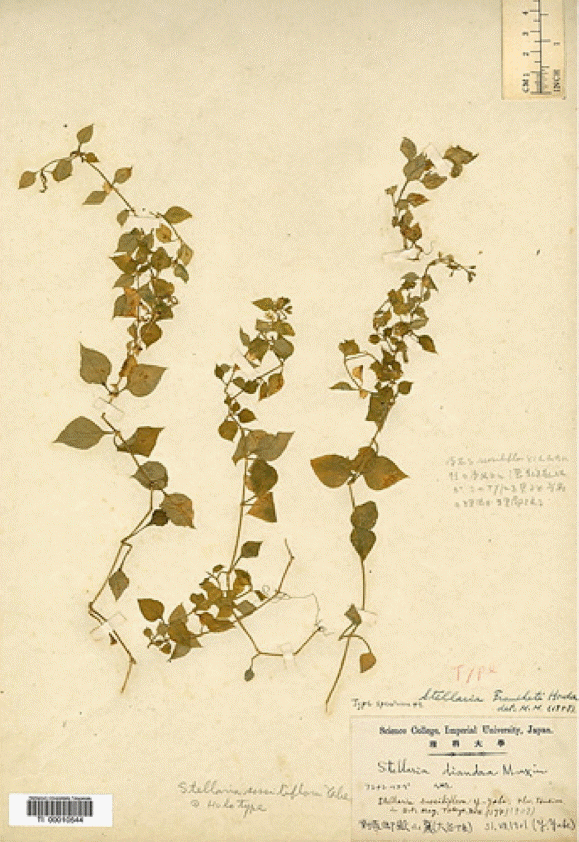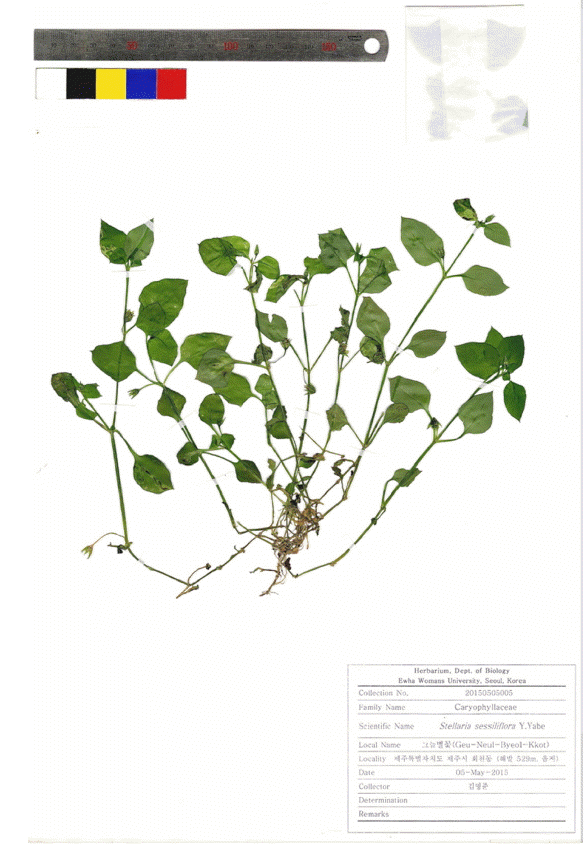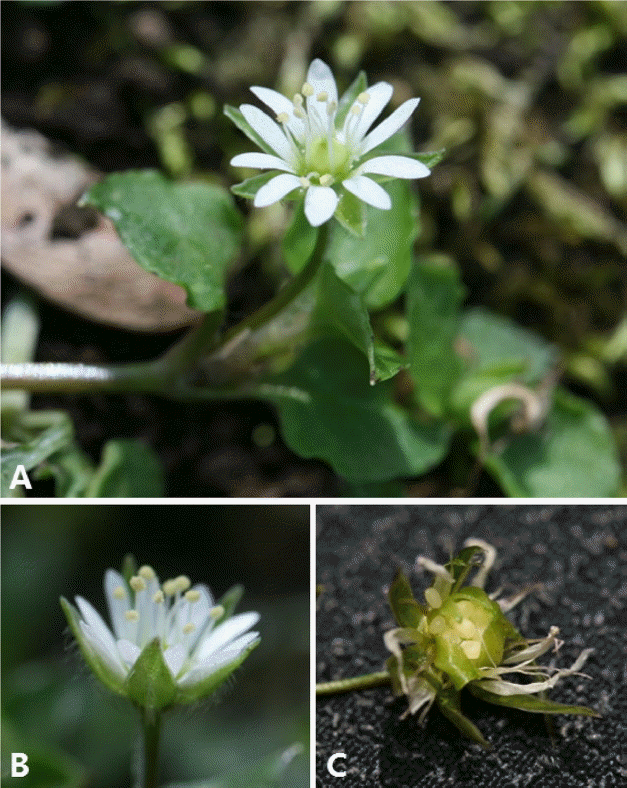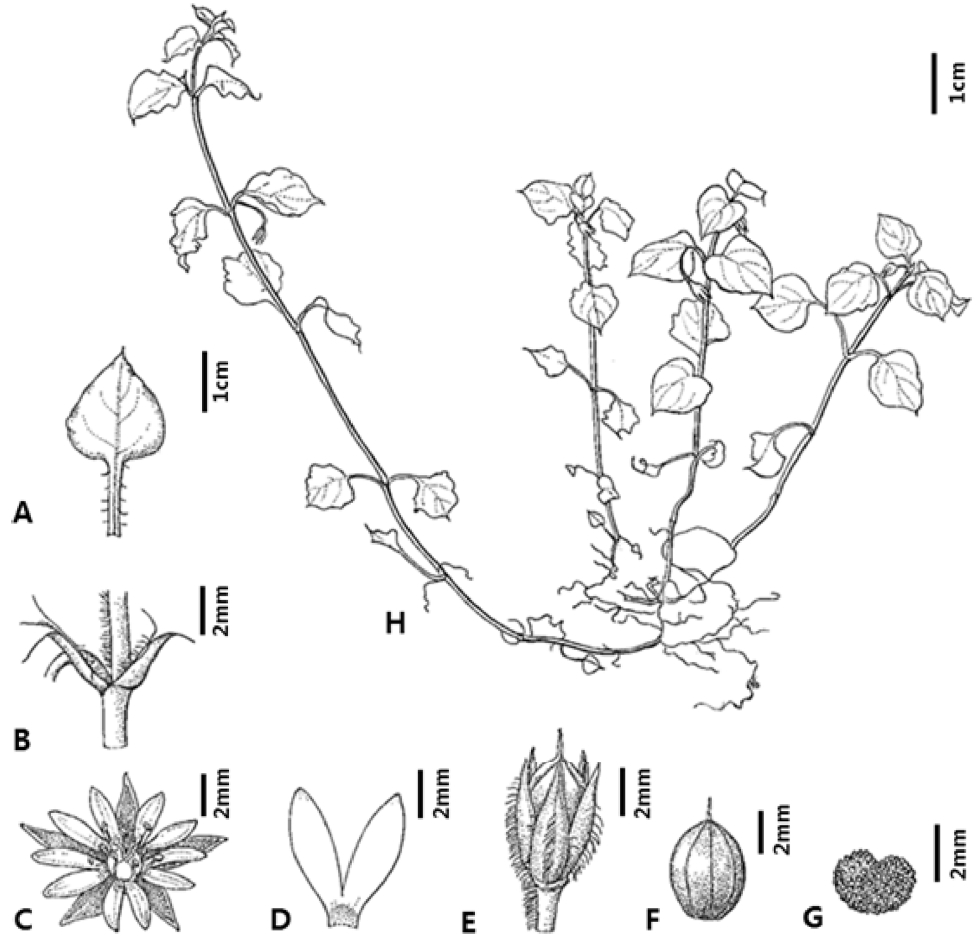/home/virtual/kjpt/journal//../xmls/kjpt-45-2-178.xml
한국 미기록식물: 그늘별꽃(석죽과)
적 요
오키나와를 제외한 일본에 분포하는 석죽과의 그늘별꽃(Stellaria sessiliflora Y. Yabe)이 최근에 제주도에서 발견되었다. 일본 식물지에 그늘별꽃이 한국(제주도)에 분포한다고 언급되어 있으며, 1935년에 제주도에서 채집된 표본의 사진(Slide No. 6294)이 이를 확증한다. 부가적으로 국립수목원과 국립산림과학원의 표본들은 이 식물이 상당한 기간동안 제주도에 분포하고 있었음을 나타낸다. 그늘별꽃은 잎이 넓고 잎가장자리가 주름지며, 줄기 윗부분의 잎에도 잎자루가 있으며, 수술이 10개인 점에서 별꽃과 구분된다. 국명은 낙엽활엽수림 밑 그늘에 분포하여 ‘그늘별꽃’으로 신칭하였다. 그늘별꽃의 형태적 특징을 기재하고, 도해, 기준표본, 확증표본 자료와 생태 사진들을 첨부하였다.
주요어: 그늘별꽃, 석죽과, 한국
Abstract
Stellaria sessiliflora Y. Yabe (Caryophyllaceae), which is known to be distributed throughout Japan excluding Okinawa, was recently found on Jeju Island in Korea. Reports on the Japanese flora state that this species is distributed on Jeju Island, and a photograph of one specimen (Slide No. 6294) collected from Jeju Island by Ohwi in May 1935 confirms this. Additionally, specimens at the National Arboretum and Korea Forest Research Institute indicate that S. sessiliflora has occurred on Jeju Island for a considerable amount of time. However, the species has never been officially listed in the flora of Korea. Stellaria sessiliflora is distinguished from S. media by having broader leaves with a slightly undulate margin, petiolate leaves on the upper part of the stem, and 10 stamens. The local name ‘Geu-Neul-Byeol-Kkot’ is given to the species based on its shady habitat under deciduous broadleaf forest. Details of the morphological characters, an illustration, the type specimen, voucher specimen data, and photographs of Stellaria sessiliflora in Korea are presented.
Keywords: Stellaria sessiliflora, Caryophyllaceae, Korea
The Genus Stellaria L. (Caryophyllaceae) comprises approximately 120 taxa with a cosmopolitan distribution ( Mabberley 1993). Eight taxa of Stellaria have been recorded in Korea: S. alsine Grimm var. undulata (Thunb.) Ohwi, S. aquatica Scopoli, S. filicaulis Makino, S. longifolia Muhlenberg, S. media (L.) Villars, S. radians Linne, S. bungeana Fenzl, and S. diversiflora Maxim. ( Choi, 2007).
Stellaria sessiliflora was described by Yoshitaka Yabe based on a specimen collected in Tsushima province in Japan on 31, July, 1901 ( Fig. 1) and it was treated as a variety of S. japonica by Makino (1909).
According to the Flora of Japan ( Satake, 1982; Akiyama, 2006), Stellaria sessiliflora occurs on Jeju Island in Korea, as well as in Japan. However, it has never been formally reported or described taxonomically in the Korean botanical literature. Several populations of S. sessiliflora have been observed from Haean-dong (23 April, 2012), Jeolmul forest, Saryeoni forest (Gyourae-ri), and Halla-eco-forest (Bonggae-dong) at an elevation of 400–600 m on Jeju Island. In addition, we found a photograph of one specimen (Slide No. 6294; Fig. 2), which was collected on Jeju Island by Ohwi in May, 1935 ( Lee, 2012). The specimen indicates that S. sessiliflora has occurred on Jeju Island for some time. Recently, S. sessiliflora has listed in Bio Resource Information Service (BRIS) without a Korean name. The Unique Resource Number 14001191150200-071-00324591 of BRIS was provided by the National Arboretum, which is a dried specimen (KHB14190986) collected by Park et al. on Jeju Island on 16 May 2012. A dried specimen (Unique Resource Number 14003771150100-071-00002407) and seeds (Unique Resource Numbers 14003771110103-071-00110888∼91) collected on 07 May 2013 documented by the Korea Forest Research Institute, though it has not formally described for the Korean flora, these specimens support the view that S. sessiliflora is distributed in Korea. The morphological characters and the habitat of these specimens observed are consistent with the original description of S. sessiliflora ( Yabe, 1903). This species is distinguished from the related S. media by its broader leaves with slightly undulate margin, its petiolate leaves on the upper part of stem, and its 10 stamens ( Table 1). In addition, as Ankei (1982) mentioned, S. sessiliflora grows in shady areas under deciduous broadleaf forest, while S. media grows in full sun or semi-shade beside roads. The local name ‘Geu-Neul-Byeol-Kkot’ (meaning Shade Chickweed in Korean) was given to S. sessiliflora based on its distinct habitat requirements.
Taxonomic Treatment
Stellaria sessiliflora Y. Yabe, Bot. Mag. (Tokyo) 17: 194 (1903).
Stellaria nemorum var. japonica Franch. & Sav., Enum. Pl. Jap. 2: 295 (1879).
Stellaria japonica (Franch. & Sav.) Makino, Bot. Mag. (Tokyo) 23: 70 (1909).
Stellaria franchetii Honda, Bot. Mag. (Tokyo) 43: 541 (1929).
Korean name: Geu-Neul -Byeol-Kkot 그늘별꽃
Herbs perennial, 10–30 cm tall. Stems usually decumbent, soft hair on a longitudinal line. Leaves ovate to cordateorbicular, 1–4 cm long, 0.7–2.5 cm wide, apex acute, margin slightly undulate, base rounded to shallowly cordate, pubescent; petiole upper one shorter than middle one, 0.2–1.5 cm long, long-pubescent. Inflorescence solitary from the axil. Flowers pedicels 0.2–1.3 cm long, pubescent; sepals elliptic lanceolate, 0.4–0.6 cm, apex acute, 1-nerved, long-pubescent; petals 5, white, deeply bifid; stamens 10; pistils 3. Fruit a capsule, ovoid-globose, 6-valved. Seeds obliquely reniform-globose, 0.1–0.12 cm diameter, dark brown, densely mammillate with semi-rounded tubercles. Flowering Apr. to May. Chromosome number 2n = 56 ( Tani, 1981).
Distribution: Japan (Hokkaido, Honshu, Shikoku, Kyushu), Korea (Jeju Island, elevation 400–600 m).
Habitat: Forest edges and wet fields beside streams under the shade or semi-shade of deciduous broadleaf forest.
Examined specimens: KOREA. Jeju-do, Jeju-si: Haeandong, 23 Apr 2012, M.J. Kim (EWH); Jeju-do: Halla-ecoforest, Bongae-dong, 15 Apr 2013, M.J. Kim (EWH); Jeju-do: Haean-dong, 21 Apr 2015, M.J. Kim and N.S. Lee (EWH); Jeju-do: Jeolmul forest, Hoecheon-dong, 5 May 2015, M.J. Kim (EWH); Jeju-do: Jocheon-eup, Seonhweul-ri, 16 May 2012, S.H. Park, S.Y. Jung, S.S. Cheong 14190986 (KHB). JAPAN, Tsushima, Mt. Ontake, 31 Jul. 1901, Y. Yabe 00010544 (TI); Tokyo, Kitaku, Takinogawa, 26 Apr. 1905, T. Makino 00010541 (TI); Gunma, Mt. Tanigawa, 24 Jun 1934, Y. Satake 00010542 (TI); Aichi pref., M. Furuse 00010543 (TI); Nagato guni, Ootseu gun, 27 Oct. 1918, Nikai-Juurou 00010545 (TI).
Stellaria sessiliflora was determined as an unresolved name in the Plant List (2013), but the name was accepted in Species 2000 & ITIS Catalogue of Life 2014 ( Roskov et al., 2014). DNA data show that it is clearly separated from other taxa in Stellaria ( Greenberg and Donoghue, 2011).
Key to Stellaria sessiliflora and the related taxa in Korea
1. Leaves at least lower ones distinctly petiolate; ovate or deltoid-ovate; hairs, if present, simple, unbranched.
1. Leaves sessile or subsessile, hairs branched.
This taxonomic key was modified from the one available in Flora of Japan ( Ohwi, 1984) and The Genera of Vascular Plants of Korea ( Choi, 2007).
ACKNOWLEDGMENTS
This research was supported by the BK21 Plus Program (Creative Academy of Ecoscience, 31Z20130012990) funded by the Ministry of Education and National Research Foundation of Korea. We thank Dr. Stephan Gale of Kadoori Farm and Botanical Garden Hong Kong for the correction of our manuscript, Ms. Akiko Shimizu of the Herbarium of the University of Tokyo and S.Y. Jung of the Korea National Arboretum for the image specimens of Stellaria sessiliflora Y. Yabe.
Fig. 1.
Type specimen of Stellaria sessiliflora Y. Yabe in TI. 
Fig. 2.
Photograpth of specimen (Slide No. 6294) of Stellaria sessiliflora Y. Yabe ( Lee, 2012). 
Fig. 3.
Voucher specimen of Stellaria sessiliflora Y. Yabe in EWH. 
Fig. 4.
Photographs of Stellaria sessiliflora Y. Yabe taken by M.J. Kim in Jeju Island on 23 April 2012. A. Flower and Leaves; B. Lateral view of flower; C. Capsule. 
Fig. 5.
Illustrations of Stellaria sessiliflora Y. Yabe A. Leaf; B. Stem and Petiole; C. Flower; D. Petal; E. Fruit; F. Matured pistil; G. Seed; H. Plant habit. 
Table 1.
The morphological comparison between Stellaria sessiliflora and S. media based on the descriptions of Japanese Flora ( Ohwi, 1984).
|
Characters |
Taxa |
|
|
S. sessiliflora
|
S. media
|
|
Plant duration |
perennial |
biennial or annual |
|
Habitat |
forest |
roadside |
|
Exposure |
shaded |
full or half exposed |
|
Stem |
ascending to decumbent |
decumbent |
|
Petiole of upper leaf |
distinct |
sessile |
|
Leaf shape |
ovate to cordate-orbicular |
ovate |
|
Leaf size (L. × W.) (cm) |
1–4 × 0.7–2.5 |
1–2 × 0.8–1.5 |
|
Leaf apex |
acuminate |
acute |
|
Leaf margin |
slightly undulated |
entire |
|
Leaf base |
rounded to shallowly cordate |
rounded to obtuse |
|
Sepal shape |
lanceolate |
narrowly oblong |
|
Seed shape |
reniform-globose |
slightly flattened globular |
|
Seed tubercles |
semi-rounded |
obtuse |
Literature Cited
Akiyama, S. 2006. Caryophyllaceae. Flora of Japan 2a. Iwatsuki, K. Boufford, DE. Ohba, H (eds.), Kodansha, Tokyo. 183-210.
Ankei, T. 1982. Habitat Gradient and Reproductive Habits of the Seven Stellaria Species in Japan, The Botanical Magazine 94: 35-48.
Choi, K. 2007. Stellaria L. The Generic Flora of Vascular Plants of Korea. Park, CW (ed.), Academic Publishing Co, Seoul. 320-322.
Greenberg, AK and Donoghue, MJ. 2011. Molecular systematics and character evolution in Caryophyllaceae, Taxon 1637-1652.
Lee, WT. 2012. The Phototype Specimens of Korean Vascular Plants(DVD). The Working Group on Plant Distribution of Asia and Korea National Arboretum (in Korean)..
Marbberley, DJ. 1993. The Plant-Book. Cambridge University Press, Cambridge. 1-706.
Makino, T. Observations on the Flora of Japan. The Botanical Magazine 23(267): 70-71.
Ohwi, J. 1984. Flora of Japan: A combined much revised, and extended translation by the author of his Flora of Japan (1953) and Flora of Japan: Pteridophyta (1957). Smithsonian Institution, Washington D. C. 3-1066.
Roskov, YT. Kunze, T. Orrell, L. Abucay, L. Paglinawan, A. Culham, N. Bailly, P. Kirk, T. Bourgoin, G. Baillargeon, W. Decock, A. De, Wever. Didžiulis, V (eds.), 2014. Species 2000 & ITIS Catalogue of Life. Retrieved Mar. 17, 2014 from www.catalogueoflife.org/col. Satake, Y. Ohwi, J. Kitamura, S. Watari, S and Tominari, T. 1982. Wild flowers of Japan IIóherbaceous plants Choripetalae. Heibonsya, Tokyo. 1-318.
Tani, K. 1981. Chromosomes of some species in Caryophyllaceae. Tokushima-ken Koto-gakko Rikagakkaishi 22: 20-27.
Yabe, Y. 1903. Florula Tsusimensis, The Botanical Magazine 17: 194.
|
|
















